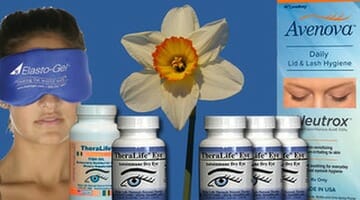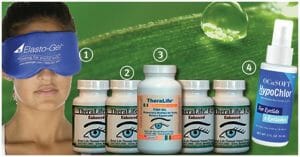
Graft Versus Host Disease
Graft-Versus-Host disease (GVHD) is a common side effect of an allogeneic (donor source) bone marrow, stem cell or cord blood transplant. In rare cases, it can result from blood transfusions. Approximately half of people who receive allogeneic transplants develop chronic GVHD. GVHD is an autoimmune disease that can affect many different parts of the body; the skin, eyes, mouth, stomach and intestines are affected most often. GVHD can range from mild to life-threatening. Ocular GVHD is a major complication that affects 60% – 80% of patients with chronic GVHD. Eye related symptoms include blurry vision, foreign body sensation, burning sensation, severe light sensitivity, chronic conjunctivitis (pink eye), dry eyes, and eye pain.
Signs and Symptoms of Graft Versus Host Disease
- New-onset dry, gritty, or painful eyes
- Photophobia – light sensitivity
- Difficulty opening the eye because of dried mucoid secretions
- Excessive tearing – watery dry eyes
- Blepharitis – eye infections
- Keratoconjunctivitis sicca- severe dry eyes
Incidence of Dry Eyes in Graft Versus Host Disease
The incidence of dry eye syndrome in GVHD varies from 22 to 80 percent. The most common complaints in patients with KCS are: foreign body sensation, ocular dryness and grittiness, conjunctival hyperemia, mucoid discharge (sticky stringy discharge) and excessive tearing (watery dry eyes).
Management and Diagnosis of Graft Versus Host Disease
- GVHD is systemic, so diagnosis and management of ocular GVHD should be approached in a multidisciplinary fashion.
- The major issue in ocular GVHD is dry eye syndrome. Pre-transplantation ophthalmic examination and Schirmer testing is recommended. Treatment with TheraLife® Autoimmune, punctal plugs and even topical cyclosporine or corticosteroid, depending on severity, can slow progression of eye problems.
- In the case of pseudomembrane formation, early debridement and topical corticosteroid and cyclosporine use are encouraged.
- Many ocular GVHD exacerbations occur during the tapering of systemic immunosuppressive therapy. Attention to topical treatment, especially pulsed corticosteroids and cyclosporine, is necessary to avoid serious systemic side effects.
Treatments for Chronic Dry Eyes Due to Graft Versus Host Disease
GVHD treatment for chronic dry eyes is multi-faceted. Due to the severity of graft vs. host disease, it must be noted that steroid drugs and antibiotics are used heavily in addition to typical treatments for chronic dry eye disease. Once your graft vs. host is under control. Try TheraLife® Eye Autoimmune to reduce inflammation and restore tear secretion gland activity, for sustainable, lasting relief all day long.
All Natural Treatment For Dry Eyes- TheraLife
K
Graft vs. Host- Chemotherapy-
I had a bone marrow transplant 4 years ago due to leukemia. This resulted in a very bad case of graft vs. host disease (GVH) where my sister’s cells were attacking my soft tissue, skin, mouth and eyes. I had almost no tears and eye pain. The GVH has since been treated but my eyes remained very dry. I used Restasis and permanent eye plugs to no avail. I finally found TheraLife and tried the TheraLife Eye Autoimmune therapy plus Fish Oil. After 2 months, my eyes became much better. I have been faithfully taking TheraLife Eye for about 2 1/2 years now and I honestly don’t know what I would do without this therapy.
Thank you for making such a great product.
V.V. Canada
*Results may vary*
References
- 1.
- Socié G, Ritz J. Current issues in chronic graft-versus-host disease. Blood. 2014 Jul 17;124(3):374-84. [PMC free article] [PubMed]
- 2.
- Antin JH, Kim HT, Cutler C, Ho VT, Lee SJ, Miklos DB, Hochberg EP, Wu CJ, Alyea EP, Soiffer RJ. Sirolimus, tacrolimus, and low-dose methotrexate for graft-versus-host disease prophylaxis in mismatched related donor or unrelated donor transplantation. Blood. 2003 Sep 01;102(5):1601-5. [PubMed]
- 3.
- Shimabukuro-Vornhagen A, Liebig T, von Bergwelt-Baildon M. Statins inhibit human APC function: implications for the treatment of GVHD. Blood. 2008 Aug 15;112(4):1544-5. [PubMed]
- 4.
- Mielcarek M, Martin PJ, Leisenring W, Flowers ME, Maloney DG, Sandmaier BM, Maris MB, Storb R. Graft-versus-host disease after nonmyeloablative versus conventional hematopoietic stem cell transplantation. Blood. 2003 Jul 15;102(2):756-62. [PubMed]
- 5.
- Ferrara JL, Levine JE, Reddy P, Holler E. Graft-versus-host disease. Lancet. 2009 May 02;373(9674):1550-61. [PMC free article] [PubMed]
- 6.
- Jamil MO, Mineishi S. State-of-the-art acute and chronic GVHD treatment. Int J Hematol. 2015 May;101(5):452-66. [PubMed]
- 7.
- Atkinson K, Horowitz MM, Gale RP, van Bekkum DW, Gluckman E, Good RA, Jacobsen N, Kolb HJ, Rimm AA, Ringdén O. Risk factors for chronic graft-versus-host disease after HLA-identical sibling bone marrow transplantation. Blood. 1990 Jun 15;75(12):2459-64. [PubMed]
- 8.
- MacMillan ML, Robin M, Harris AC, DeFor TE, Martin PJ, Alousi A, Ho VT, Bolaños-Meade J, Ferrara JL, Jones R, Arora M, Blazar BR, Holtan SG, Jacobsohn D, Pasquini M, Socie G, Antin JH, Levine JE, Weisdorf DJ. A refined risk score for acute graft-versus-host disease that predicts response to initial therapy, survival, and transplant-related mortality. Biol Blood Marrow Transplant. 2015 Apr;21(4):761-7. [PMC free article] [PubMed]
- 9.
- Gale RP, Bortin MM, van Bekkum DW, Biggs JC, Dicke KA, Gluckman E, Good RA, Hoffmann RG, Kay HE, Kersey JH. Risk factors for acute graft-versus-host disease. Br J Haematol. 1987 Dec;67(4):397-406. [PubMed]
- 10.
- Nassereddine S, Rafei H, Elbahesh E, Tabbara I. Acute Graft Versus Host Disease: A Comprehensive Review. Anticancer Res. 2017 Apr;37(4):1547-1555. [PubMed]
Autoimmune Dry Eye
References
- 1.Socié G, Ritz J. Current issues in chronic graft-versus-host disease. Blood. 2014 Jul 17;124(3):374-84. [PMC free article] [PubMed]
- 2.Antin JH, Kim HT, Cutler C, Ho VT, Lee SJ, Miklos DB, Hochberg EP, Wu CJ, Alyea EP, Soiffer RJ. Sirolimus, tacrolimus, and low-dose methotrexate for graft-versus-host disease prophylaxis in mismatched related donor or unrelated donor transplantation. Blood. 2003 Sep 01;102(5):1601-5. [PubMed]
- 3.Shimabukuro-Vornhagen A, Liebig T, von Bergwelt-Baildon M. Statins inhibit human APC function: implications for the treatment of GVHD. Blood. 2008 Aug 15;112(4):1544-5. [PubMed]
- 4.Mielcarek M, Martin PJ, Leisenring W, Flowers ME, Maloney DG, Sandmaier BM, Maris MB, Storb R. Graft-versus-host disease after nonmyeloablative versus conventional hematopoietic stem cell transplantation. Blood. 2003 Jul 15;102(2):756-62. [PubMed]
- 5.Ferrara JL, Levine JE, Reddy P, Holler E. Graft-versus-host disease. Lancet. 2009 May 02;373(9674):1550-61. [PMC free article] [PubMed]
- 6.Jamil MO, Mineishi S. State-of-the-art acute and chronic GVHD treatment. Int J Hematol. 2015 May;101(5):452-66. [PubMed]
- 7.Atkinson K, Horowitz MM, Gale RP, van Bekkum DW, Gluckman E, Good RA, Jacobsen N, Kolb HJ, Rimm AA, Ringdén O. Risk factors for chronic graft-versus-host disease after HLA-identical sibling bone marrow transplantation. Blood. 1990 Jun 15;75(12):2459-64. [PubMed]
- 8.MacMillan ML, Robin M, Harris AC, DeFor TE, Martin PJ, Alousi A, Ho VT, Bolaños-Meade J, Ferrara JL, Jones R, Arora M, Blazar BR, Holtan SG, Jacobsohn D, Pasquini M, Socie G, Antin JH, Levine JE, Weisdorf DJ. A refined risk score for acute graft-versus-host disease that predicts response to initial therapy, survival, and transplant-related mortality. Biol Blood Marrow Transplant. 2015 Apr;21(4):761-7. [PMC free article] [PubMed]
- 9.Gale RP, Bortin MM, van Bekkum DW, Biggs JC, Dicke KA, Gluckman E, Good RA, Hoffmann RG, Kay HE, Kersey JH. Risk factors for acute graft-versus-host disease. Br J Haematol. 1987 Dec;67(4):397-406. [PubMed]
- 10.Nassereddine S, Rafei H, Elbahesh E, Tabbara I. Acute Graft Versus Host Disease: A Comprehensive Review. Anticancer Res. 2017 Apr;37(4):1547-1555. [PubMed]
More References
- 1.Dry eye as a mucosal autoimmune disease. Stern ME, Schaumburg CS, Pflugfelder SC. Int Rev Immunol. 2013;32:19–41. doi: 10.3109/08830185.2012.748052. [DOI] [PMC free article] [PubMed] [Google Scholar]
- 2.TFOS DEWS II report executive summary. Craig JP, Nelson JD, Azar DT, et al. Ocul Surf. 2017;15:802–812. doi: 10.1016/j.jtos.2017.08.003. [DOI] [PubMed] [Google Scholar]
- 3.The definition and classification of dry eye disease. https://www.tearfilm.org/pdfs/OM%20-%20Definition%20. Ocul Surf. 2007;5:75–92. doi: 10.1016/s1542-0124(12)70081-2. [DOI] [PubMed] [Google Scholar]
- 4.TFOS DEWS II definition and classification report. Craig JP, Nichols KK, Akpek EK, et al. Ocul Surf. 2017;15:276–283. doi: 10.1016/j.jtos.2017.05.008. [DOI] [PubMed] [Google Scholar]
- 5.TFOS DEWS II diagnostic methodology report. Wolffsohn JS, Arita R, Chalmers R, et al. Ocul Surf. 2017;15:539–574. doi: 10.1016/j.jtos.2017.05.001. [DOI] [PubMed] [Google Scholar]
- 6.TFOS DEWS II management and therapy report. Jones L, Downie LE, Korb D, et al. Ocul Surf. 2017;15:575–628. doi: 10.1016/j.jtos.2017.05.006. [DOI] [PubMed] [Google Scholar]
- 7.TFOS DEWS II pathophysiology report. Bron AJ, de Paiva CS, Chauhan SK, et al. Ocul Surf. 2017;15:438–510. doi: 10.1016/j.jtos.2019.08.007. [DOI] [PubMed] [Google Scholar]
- 8.TFOS DEWS II iatrogenic report. Gomes JA, Azar DT, Baudouin C, et al. Ocul Surf. 2017;15:511–538. doi: 10.1016/j.jtos.2017.05.004. [DOI] [PubMed] [Google Scholar]
- 9.Inflammation and dry eye disease-where are we? Rao SK, Mohan R, Gokhale N, Matalia H, Mehta P. Int J Ophthalmol. 2022;15:820–827. doi: 10.18240/ijo.2022.05.20. [DOI] [PMC free article] [PubMed] [Google Scholar]
- 10.Effectiveness of mediterranean diet implementation in dry eye parameters: a study of PREDIMED-PLUS trial. Molina-Leyva I, Molina-Leyva A, Riquelme-Gallego B, Cano-Ibáñez N, García-Molina L, Bueno-Cavanillas A. Nutrients. 2020;12 doi: 10.3390/nu12051289. [DOI] [PMC free article] [PubMed] [Google Scholar]


